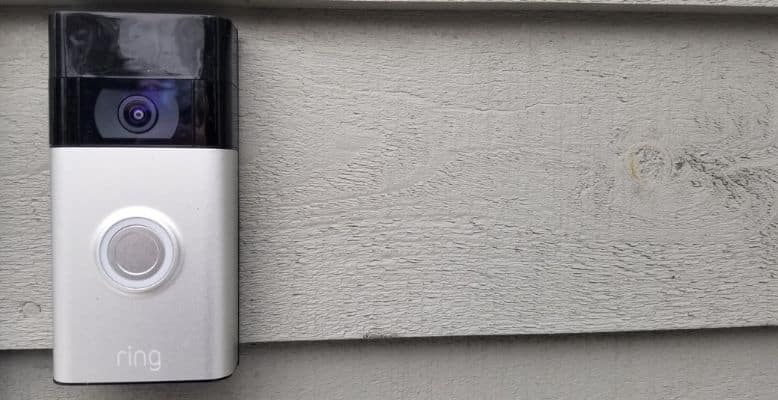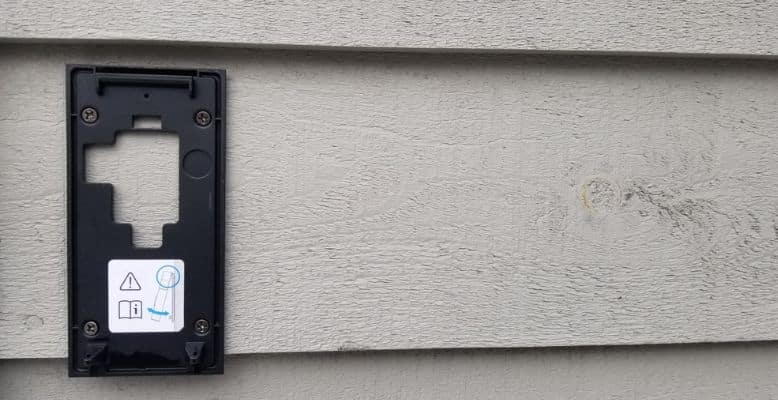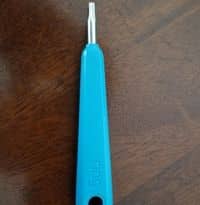
Welcome to our guide on how to install a Ring Doorbell 2! This smart doorbell is an excellent addition to any home, providing increased security and the ability to see and communicate with visitors from anywhere.
With its sleek design and advanced features, it is a popular choice for homeowners looking to upgrade their home security systems. Read our review of it here.
In this guide, we’ll walk you through the installation process step-by-step before setting it up, so you can enjoy the benefits of your new doorbell in no time. Let’s get started!
Here's what we cover:
Tools And Materials Needed
Before you begin the installation process for your Ring Doorbell 2, you’ll need to gather a few tools and materials. Here’s a list of what you’ll need:
- All the mounting hardware included with your doorbell has the mounting plate, screws, security screwdriver, etc.
- You’ll need a Phillips head screwdriver to attach the mounting plate to the wall.
- A level will help ensure your doorbell is mounted straight and evenly.
- Drill: You’ll need a drill to create holes for the mounting screws.
- Tape measure to determine the right height to install at.
- Mounting brackets depend on where you are installing the doorbell. Later in this guide, we go through all the different mounting options.
Preparation
Before you get started, you will want to:
- Gather all of your tools and materials before beginning the installation process. This will ensure that you have everything you need and can work efficiently.
- Charge the battery. Before installing the doorbell, make sure the battery is fully charged. This will ensure that the doorbell has enough power to function correctly.
- Use the level to mark the drill holes on the mounting plate. Ensure the mounting plate is level before marking the holes to ensure proper installation.
- Choose the right location for your doorbell.
How High Should The Ring Doorbell 2 Be Mounted?
It should be mounted at the height of 48 inches to 53 inches from the ground. This is the recommended height for optimal viewing and accessibility. It’s essential to mount the doorbell at the correct height to ensure that visitors are in view of the camera and that you can easily access the doorbell button.
Installation Options
There are three main options for installing a Ring Doorbell 2:
- Hardwire with an existing doorbell and chime: If you already have a wired doorbell system, you can hardwire it to the existing wiring and the correct wiring diagram. This will allow the doorbell to ring your existing doorbell chime whenever someone rings the doorbell. See a detailed instruction guide here.
- Hardwire without an existing doorbell: If you don’t have a wired doorbell system, you can install one by running an electrical wire from a transformer to the doorbell location. This will allow you to hardwire the doorbell and add a chime to your home. See a detailed instruction guide here.
- Wireless battery-powered: If you don’t have an existing doorbell system and don’t want to run electrical wire, you can install it wirelessly using the included battery. The battery will need to be charged regularly, but this option allows for a quick and easy installation process.
Step By Step – How To Install
To install wirelessly:
Attach the mounting plate to the wall.
Choose a location for the doorbell within reach of a power outlet and at the height of 48 inches to 53 inches from the ground. Use a drill and the appropriate screws or anchors to attach the mounting plate to the wall.
Charge the battery.
Use the included micro-USB charging cable to connect the doorbell to a power outlet. The doorbell’s battery will need to be charged before it can be used.
Connect the doorbell to the mounting plate.
Line up the doorbell with the mounting plate, and slide it onto the plate until it clicks into place. Use the security screwdriver to install the security screws on the bottom of the doorbell.
Download the Ring app.
To set up and use the doorbell, you must download the Ring app to your smartphone or tablet. Follow the on-screen instructions to create an account and pair the doorbell with the app.
Set up your doorbell.
Once the doorbell is paired with the app, you can customize the settings and preferences for your doorbell. This includes setting up motion detection, adjusting the camera’s field of view, and configuring notification settings.
Test the doorbell.
Press the doorbell button to ensure it is working correctly and that you receive notifications on your phone. You can also test the doorbell’s camera by checking the live feed in the app.
Enjoy your new doorbell!
With the installation process complete, you can start using your Ring Doorbell 2 to see and communicate with visitors from anywhere.
Here is a helpful video as well:
Mounting Bracket Options
Depending on your installation needs and preferences, several mounting bracket options are available.
- Adapter plates: Adapter plates are available for the Ring Doorbell 2 to mount the doorbell to an existing doorbell plate or bracket. I recommend this one.
- Adjustable angle mount: The adjustable angle mount allows you to adjust the doorbell angle for a better viewing angle. This is especially useful for doors not at a 90-degree angle to the wall. I recommend this one.
- 90-degree corner mount kit: The 90-degree corner mount kit is designed for use on corners, allowing you to mount the doorbell at a 90-degree angle to the wall. I recommend this one.
- Wedge mount kit: The wedge mount kit is a slanted mounting plate that allows you to adjust the angle of the doorbell for a better viewing angle. I recommend this one.
- Side mount: The side mount allows you to mount the doorbell to the side of a door or window frame. I recommend this one.
- Solar mount: The solar mount is a mounting bracket with a solar panel to charge the doorbell’s battery. This is a good option for areas where a power outlet is not easily accessible, but the sun is for a solar charger. I recommend this one.
Mounting On Different Surfaces
Mounting On Brick
To mount the Ring Doorbell 2nd generation on brick, you must use masonry screws or anchors. Masonry screws are designed for brick, concrete, and other masonry surfaces. They have a sharp thread that allows them to grip the brick firmly, providing a secure hold for the doorbell.
An adhesive mount like this is another option for mounting the doorbell on brick.
To install on brick with screws, you will also need a drill with a 3/16-inch or 5/32-inch drill bit to pre-drill the holes for the screws or anchors. Use your surface’s appropriate size drill bit to ensure a secure hold.
Mounting On Vinyl Siding
To install the doorbell with screws, you will need screws specifically designed for vinyl siding. These screws have a particular thread and coating that allows them to grip the vinyl siding firmly, providing a secure hold for the doorbell. To install the doorbell using screws, you will also need a drill with a 1/4-inch drill bit to pre-drill the holes for the screws.
To install the doorbell with adhesive, look at the recommended adhesive mount I like.
Mounting On Stucco
To mount it on stucco, you can use either masonry screws, anchors, or adhesive mount.
To install the doorbell with screws or anchors, you will need masonry screws or anchors specifically designed for use on stucco. These screws or anchors have a sharp thread and are made of a material that can grip the stucco firmly, providing a secure hold for the doorbell. To install the doorbell using screws or anchors, you will also need a drill with a 3/16-inch or 5/32-inch drill bit to pre-drill the holes for the screws or anchors.
Maintenance
To maintain and care for your Ring Doorbell 2, follow these recommendations:
- Clean the doorbell regularly. To clean the doorbell, use a soft, dry cloth to wipe away any dust or dirt. Avoid using harsh chemicals or cleaners, as these may damage the doorbell.
- Charge the battery as needed.
- Update the firmware regularly. To ensure the doorbell is running smoothly and to take advantage of new features, update the firmware to the latest version. You can do this in the Ring app by selecting the device settings and selecting “Check for Updates.”
FAQ
How do I remove the doorbell from the mounting bracket?
Removing the doorbell from the bracket is necessary when you want to reset it or bring it inside to charge the battery.
Remove the two security screws with the small security screwdriver included with your doorbell.
Next, you grasp the doorbell near the bottom and pull up. It should come off.
To install it back on the mount, do the same thing but the opposite.
What is the security screw size?
The Ring Doorbell 2 uses a security screw to hold the doorbell in place on the mounting plate. The security screw is a Tamper Resistant Torx screw, also known as a TR-6 screw. The TR-6 security screw is designed to prevent tampering and unauthorized removal of the doorbell.
To remove the security screw, you will need a Tamper Resistant Torx driver or screwdriver. These tools are specifically designed to fit the TR-6 security screw and allow you to remove it without damaging the screw or the doorbell.
Can I install 2 Ring doorbells?
Yes, you can install multiple Ring Doorbells in your home. Each Ring Doorbell requires its own mounting plate and power source, so you must follow the installation instructions for each doorbell separately. You can also find more info on using 2 Ring doorbells here.
Are replacement screws available if I have a stripped screw?
If you have a stripped screw on your Ring Doorbell 2, you may be able to find replacement screws at a hardware store or online. It is essential to use the correct size and type of screws to ensure a secure hold and proper doorbell installation.
If you cannot find replacement screws, you may need to remove the stripped screw and fill the hole with a wood filler or epoxy. Once the filler has dried, you can drill a new hole and install a new screw.
Conclusion
Installing a Ring Doorbell 2 is a straightforward process that can provide numerous benefits for your home. Following the steps outlined above, you can easily install the doorbell wirelessly and enjoy its increased security and convenience.
